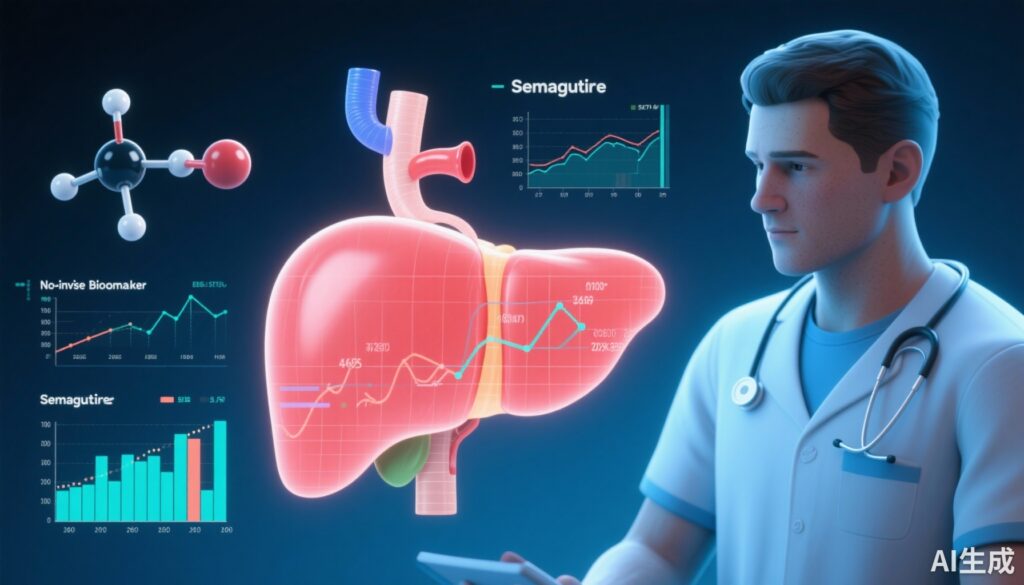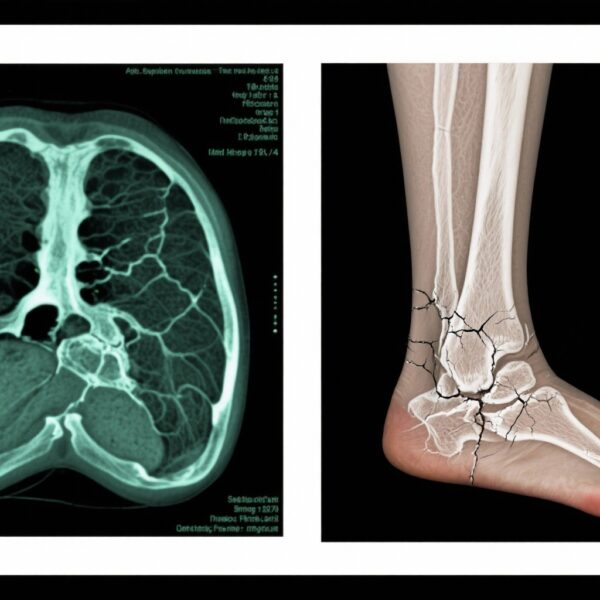Highlight
- Noninvasive tests (NITs) showed significant and early reductions in fibrosis and liver injury markers in MASH patients treated with semaglutide.
- Changes in NITs correlated with histologic resolution of MASH and decreased fibrosis progression after 72 weeks of treatment.
- Patients with elevated baseline liver stiffness measure (LSM) or enhanced liver fibrosis (ELF) scores showed meaningful improvements under semaglutide versus placebo.
- Lower baseline fibrosis-related NIT scores predicted spontaneous improvement, with the SomaSignal fibrosis test accurately identifying fibrosis improvement.
Study Background
Metabolic dysfunction-associated steatohepatitis (MASH), formerly known as nonalcoholic steatohepatitis (NASH), represents a progressive liver disease characterized by steatosis, inflammation, and varying degrees of fibrosis. MASH can progress to cirrhosis, hepatic failure, and hepatocellular carcinoma, posing significant clinical and public health challenges worldwide due to its increasing prevalence, especially among individuals with metabolic syndrome, obesity, and type 2 diabetes mellitus. Semaglutide, a glucagon-like peptide-1 (GLP-1) receptor agonist, has emerged as a promising therapeutic agent for MASH by improving metabolic parameters and demonstrating antifibrotic effects in clinical trials.
Liver biopsy remains the gold standard for diagnosis and assessment of histological response, but repeated biopsies are invasive, carry risks, and are impractical for longitudinal monitoring. This context underscores the urgent need for validated noninvasive tests (NITs) to track disease progression and treatment response in MASH.
Study Design
This analysis is based on a retrospective evaluation of a multicenter, randomized, placebo-controlled phase 2b trial investigating semaglutide’s effect in patients with biopsy-confirmed MASH and liver fibrosis stages 1 to 3. The study included 268 patients who received 72 weeks of treatment—202 patients in the pooled semaglutide arm (doses 0.1, 0.2, or 0.4 mg) and 66 patients in the placebo group.
Liver biopsies were performed at baseline and at week 72 to ascertain histologic changes. Serum samples and clinical data were collected at baseline, week 28, week 52, and week 72 to assess the performance of 17 different NITs. These encompassed biochemical markers (alanine aminotransferase, aspartate aminotransferase), fibrosis scores (fibrosis-4 index [FIB-4]), liver stiffness measurement (LSM) assessed by transient elastography, and the enhanced liver fibrosis (ELF) test.
The primary exploratory endpoint was the change in NIT values over the treatment period and their association with histologic response defined by resolution of MASH and fibrosis progression.
Key Findings
The analysis demonstrated consistent and statistically significant decreases in all evaluated NIT scores in patients treated with semaglutide compared with placebo. Notably, these reductions were detectable as early as week 28 and sustained through week 72.
Treatment response was operationalized as an improvement of ≥ 20% in NIT values or a reduction of ≥ 0.5 units for ELF. Significantly more patients in the semaglutide group met these response criteria, aligning with improved histologic outcomes.
Among patients with elevated baseline LSM (≥ 8 kPa), 55% of those receiving semaglutide achieved reductions below this threshold, compared to only 21% in the placebo group (P = .001). Similarly, for baseline ELF values ≥ 9.8 units, 50% of semaglutide-treated patients improved below this cutoff versus 28% with placebo (P = .047).
These NIT improvements correlated with higher rates of histologic MASH resolution and attenuated fibrosis progression. The findings suggest that semaglutide’s therapeutic effects extend beyond biochemical improvements to measurable histopathologic benefit.
Interestingly, baseline fibrosis-related NIT levels were predictive of spontaneous improvement. The SomaSignal fibrosis test, a novel assay, classified fibrosis improvement with 74.2% accuracy, highlighting its potential utility in identifying patients who may experience natural disease regression.
Expert Commentary
The study supports the feasibility of integrating noninvasive biomarkers into clinical practice as surrogate indicators of therapeutic response in MASH management. By validating NITs against liver biopsy outcomes, this analysis addresses a critical gap—providing clinicians with less invasive but reliable tools to monitor treatment efficacy.
However, limitations include the retrospective nature of this analysis and the moderate sample size. Further prospective validation in larger, more diverse cohorts and correlation with hard clinical endpoints such as progression to cirrhosis or liver-related morbidity will reinforce NITs’ role in routine care.
Mechanistically, semaglutide likely improves hepatic metabolism and reduces inflammatory and fibrogenic signaling pathways, which is reflected in both histology and biomarker profiles. The early detection of treatment effects at 28 weeks offers a clinical advantage by allowing timely therapeutic decisions.
Conclusion
This phase 2b trial analysis furnishes compelling evidence that multiple NITs effectively track semaglutide response in MASH patients. The observed correlations between biomarker improvements and histologic benefits endorse the clinical utility of NITs for longitudinal assessment in place of repeated liver biopsies.
Implementation of NITs will facilitate personalized treatment monitoring, potentially improving patient outcomes through earlier intervention adjustments. Future studies should aim to standardize NIT thresholds for clinical decision-making and validate the association of NIT changes with long-term liver-related clinical outcomes.
References
Nitze LM, Ratziu V, Sanyal AJ, Wong VW, Balendran C, Fleckner J, Skalshøi Kjær M, Krarup N, Anstee QM. Exploration of Multiple Non-Invasive Tests for Assessing Response to Treatment in a Semaglutide Phase 2b Trial in Patients With MASH. Aliment Pharmacol Ther. 2025 Sep 23. doi: 10.1111/apt.70376. Epub ahead of print. PMID: 40985232.
Younossi ZM, et al. Global Epidemiology of Nonalcoholic Steatohepatitis–Related Liver Disease. Clin Liver Dis. 2023;27(4):627-642.
Friedman SL, et al. Mechanisms of NAFLD development and therapeutic strategies. Nat Med. 2018;24(7):908-922.
Sanyal AJ, et al. The Role of GLP-1 Receptor Agonists in NASH Treatment: Current Evidence and Future Directions. Hepatology. 2022;75(2):456-471.


